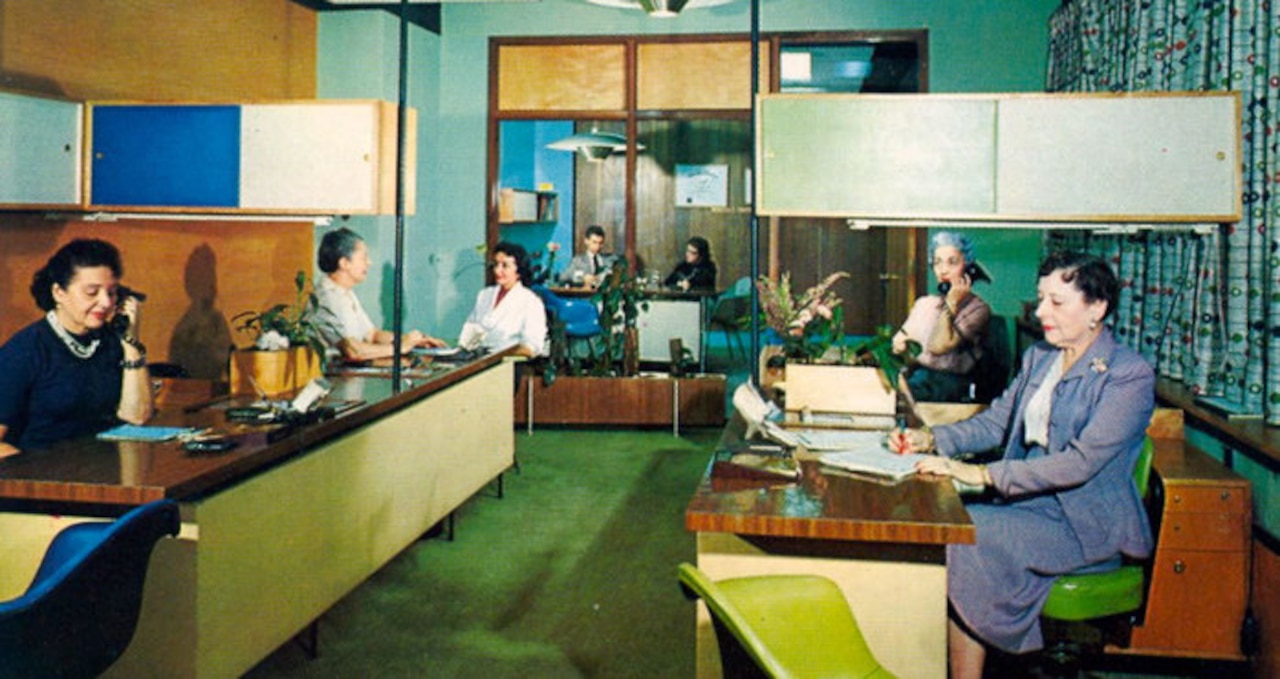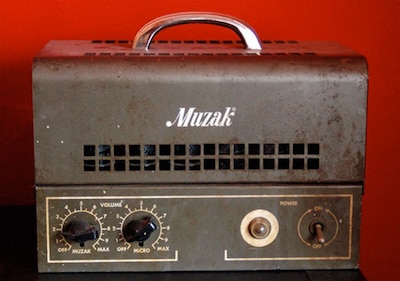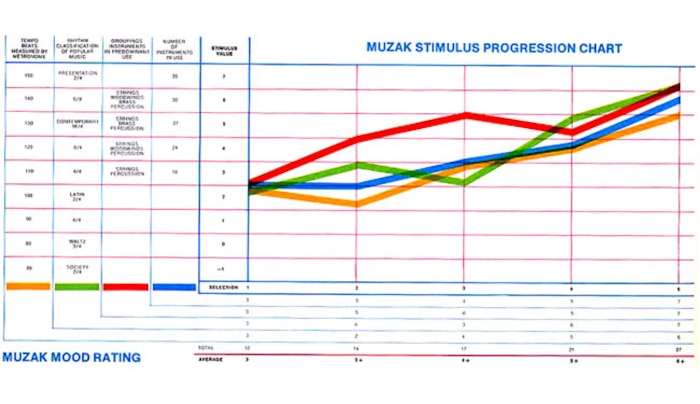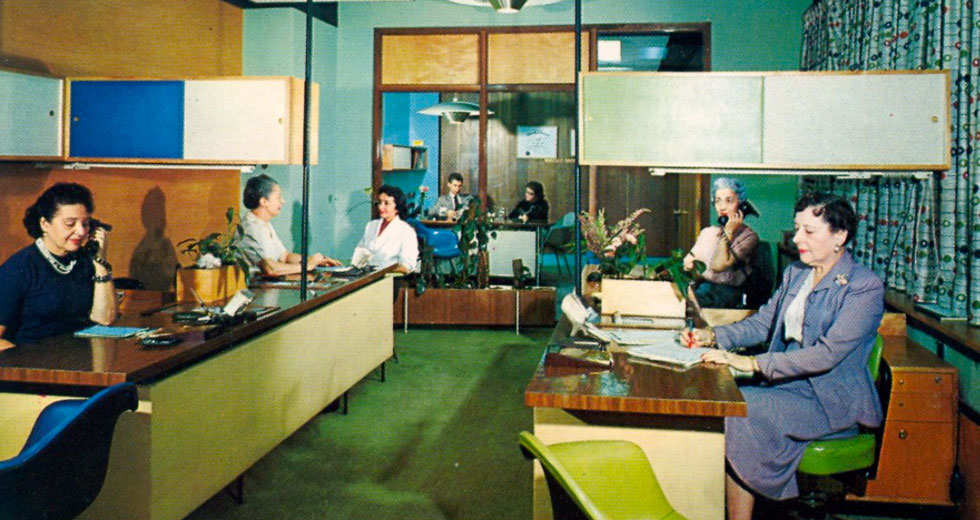
Elevator Going Down: The Story Of Muzak
When Congressman Paul Ryan mounted the stage and strode to the lectern at the Republican National Convention in Tampa Bay this summer, he needed to distance himself from his potential future boss, Willard ‘Mitt’ Romney, without actually criticising any of the man’s policies. Instead of mocking his health care plan, he mocked Mitt’s musical taste: “We're a full generation apart, Governor Romney and I,” Ryan said, in a sing-songy, story-telly tone. “And, in some ways, we're a little different. There are the songs on his iPod which I've heard on the campaign bus and on many hotel elevators.”
BAM: instant conservative bad boy. Romney didn’t care, of course, because Paul Ryan wasn’t really mocking Mitt. He was mocking Muzak.
That is probably the lowest elevator music (aka ‘mood music’, ‘beautiful music’, ‘muzak’, ‘MUZAK’) will ever get. From top of the technological heap in the 1930s to sculpting the spending habits and productivity in the 60s to pioneering music branding in the early 2000s to going bankrupt in 2009, bought for cents on the dollar and now, tragically, a political punchline in 2012. The heir to American conservatism, saying, in effect, “Elevator music isn’t just for nerds, it’s for Republican nerds.” Ouch. Shit’s cold, Paul Ryan.
But that’s not the whole story. It’s not even part of the story. After 80 years of passively and not-so-passively invading our public spaces, muzak doesn’t have many strident advocates (we found one) and it has many detractors. Piped music has been around nearly as long as radio, and the company behind it did pioneering scientific work in understanding the way music relates to mood. Later, it did brash (if annoying) brand work teaching massive retailers how to tell their story through their in-store soundtrack.
.jpg?auto=format&w=700)
Muzak was among the first productivity aids of the modern era, and probably the first step into the annoying world of sensory marketing. It also spawned a few bona fide musical movements, and inspired at least one musical giant (Brian Eno) to launch a counter movement. Meanwhile, Muzak’s descendants are still helping global brands like Gucci decide which Flo Rida cut goes best with a bamboo leather top handle bag. That’s a big, mellow footprint to leave on music. And along with it comes a story of how high we fly and how far we fall, and what might be learned from the searing trajectory.
First, some definitions: there is muzak and then there is Muzak, the way there is kleenex – American slang for tissue paper – and there is Kleenex – an American brand of tissue paper. Capital M Muzak is the most successful, most infamous purveyor of piped music. They originated the concept, then so completely cornered the market in sending soft, simplified melodic sounds into the recessed speakers of your favourite department store and elevator shaft, that people just started calling the entire genre ‘muzak’.
But there’s an added wrinkle, because muzak also sort-of refers to the original mode of conveyance. It was wired wireless, radio transmitted not through the air but through power lines. It is a commodity rooted in a technology, and that is a first lesson of Muzak: whenever your product is technology-centred, your product will be constantly attacked by emerging tech. First by radio, then by satellite, then – ultimately and perhaps decisively – things like Pandora and Spotify. But more on that later.
The guy that invented the technology making piped music possible was George Owen Squier, a Major General in the United States Army signal corps. His invention of multiplexing – sending several analogue signals over a single line – in 1910 paved the way for the company he would start in 1922, Wired Radio, which would eventually be renamed Muzak. Multiplexing, as an aside, has had a ton of other uses as well. The first wired computer network you ever connected to, in college or at your first awful job after college, probably used principles of multiplexing to link the computers to the router that led to that crazy thing called the internet.
General Squier was more of a communicator than a fighter, and mostly occupied himself with how to get messages from one place to another. He was primarily an inventor, but also quite a showman, knowing how to ignite reporters’ imaginations. A breathless 1914 report in Scientific American tells how Squier had been able to pick up a broadcast from Nauen, Germany while in the woods around Washington DC, using a large oak tree as an antenna. Any tree would do, Squier told the reporter, though it had to be a living tree, and one in full foliage was best.

In addition to his patent for “Tree Telephony,” Squier held several more for transmitting information over electrical wires, and he planned to use them to create a subscription service to deliver music directly to electrical utility consumers. The early tests were conducted on customers on New York’s Staten Island. Subscribers were given a box that looked like a gramophone and they were charged directly to their electrical bill. The technology took until the early 1930s to mature, though, and radio had matured by then as well, beaming out endless free music and news to anyone who could pick up the signal.
Accordingly, it first had a hard time keeping up with the variety and cost of radio, so it moved to commercial. (Later, it would be slow to react to satellite radio’s impact on the market, ditto Pandora and Spotify. Originally called Wired Radio, the company was renamed Muzak – a play on Kodak – in 1934 and began going after commercial clients, sending out its first broadcast to commercial companies in 1936. Warner Brothers bought the company in ‘37 and then sold it again after World War II.

In the 40s, Muzak got more deliberate about the type and tempo of the music it piped, trademarking “Stimulus Progression”, which gradually amped up the tempo and intensity of its easy listening in 15-minute intervals. The company used only instrumental music, because it was thought that lyrics might knock a worker or a patron out of the rhythm of building or buying or whatever activity the Muzak was piped in to encourage. A raft of in-house research swore that the results of such stimulus was too incredible to ignore. In the words of the New Yorker, “It was pseudoscience, but it remained alive at the company until the late nineties, partly because it was a useful marketing tool and partly because it seemed so plausible: most people really were happier and more productive when there was something humming along in the background.”
It was pseudoscience, but it remained alive at the company until the late ’90s...
Soon, background music was everywhere, according to Joseph Lanza, author of Elevator Music, an exhaustive Muzak history and hagiography. Muzak was piped into offices, department stores, supermarkets, restaurants, factories and even a few elevators. As Lanza says, “It became a pervasive soundtrack for much of American life.”
And whether or not the company’s science was sound, it was self-fulfilling. Easy listening became a thing people wanted in their homes. In the 40s, record companies began following Muzak’s lead, putting out albums “of soft, melodic instrumental versions of popular tunes, usually with shimmering strings, along with pianos, guitars, or horns to bring out the main melody,” Lanza told us by phone. The classic mood music motif was in place from very early on, and became intertwined with a certain mode of pop music through the 50s and 60s, when, according to Lanza, “massed strings became the musical currency for many popular recordings as well as movie soundtracks [and] likewise became the bulk of Muzak's output.”
But then, in the late-60s, when music become a form of protest and lyrics began to have an utterly pervasive importance in the cultural revolution, Muzak had no real answer. A small Seattle company called Yesco began selling what it called foreground music – a direct jab at Muzak's background music. This ended up being the direction culture went, and Muzak was slow to move. When the company finally did its first programme with lyrics, in 1984, it was after a merger, and was produced by Yesco.
Even when Muzak was in low regard, though, it had a powerful impact. In 1978, the legendary producer, musician and composer Brian Eno released Music For Airports, which sought to create instrumental music that was more art than science. In the album’s liner notes, he made it clear that this was a response to companies like Muzak, who had pioneered an idea Eno didn’t think had been fully artistically explored. In doing so, he created an entire genre we all recognise: ambient.
“Whereas [canned music’s] intention is to ‘brighten’ the environment by adding stimulus to it,” Eno wrote in the liner notes of Music For Airports, “Ambient Music is intended to induce calm and a space to think.” As opposed to Muzak, which Eno thought forced the listener into a certain mode of behaviour, he said, “Ambient Music must be able to accommodate many levels of listening attention without enforcing one in particular; it must be as ignorable as it is interesting.”
The idea of foreground music took a turn toward branding in the late 1990s, when Alvin Collis – a consultant who eventually became Muzak’s vice-president of strategy and brand – walked into a store and had an epiphany. “I realised then that Muzak’s business wasn’t really about selling music,” Collis told the New Yorker. “It was about selling emotion – about finding the soundtrack that would make this store or that restaurant feel like something, rather than being just an intellectual proposition.”

That became Muzak’s direction in 1997. For Collis, these soundtracks were all about taking the original pop tracks and getting shoppers to identify bands with particular brands. Rather than turning them into simple instrumentals, the point was to just play the original record in your store, as a way of identifying your product with a population of people who already identified with a band or style of music.
Dana McKelvey is a former Creative Manager at Muzak – one of a handful of offspring of the company that have struck out on their own. She began at the company in 2001, doing exactly what Collis described, creating personalised branding projects for Ann Taylor and Loft, and was eventually promoted to oversee the branding projects. She says her job was to make it clear that Loft was a brand for young women, so she programmed the store full of music by ‘fun’ young women – early career Sheryl Crow, say.
As the work of McKelvey, and others like her, became the primary course for Muzak, instrumental elevator music slowly shrank until its only foothold was a small, fervent pocket in Japan. “[The Japanese] still really love that environmental, instrumental music,” McKelvey says with a laugh. “They have a strange appreciation for it there.” Everyone else, she says, has moved on.
Ultimately, though, the hyper-curated music-branding model wasn't sustainable for a company as large as Muzak, which McKelvey characterises as slow to react to changing trends. Muzak went bankrupt in 2008, and in 2011 so did a big rival, DMX. Both were bought up by Canada-based Mood Media.
People have Muzak as the precursor to the all-encompassing musical soundtrack – to Napster and the iPod – and that’s true, but only to a point. Insofar as it was a closed system, a curated system and a discretely distributed system, it was more like radio than a mixtape, and more like iTunes than bittorrent: static, curated, non-transferable. Muzak originally offered a few pre-recorded instrumental packages and that gave way to more choice and eventually personalised sonic branding, McKelvey sees the future turning further toward the individual listener.
As a tech-driven company, Muzak failed when it didn’t keep up with changing tech. McKelvey says she saw this in the last decade, when their 80 percent market share slipped, as she believes, “because, they didn’t come up with unique solutions as the technology changed.”
People will be offering music to the companies that once offered music to the people.
Other companies are now taking the ball. McKelvey uses the example of the Gucci phone app – which lets you take their music branding with you when you leave the store – but goes one step further. She’d like to see the opposite happen. If music branding is about connecting with a customer, she asks, “why can’t that customer come into a store and share their music with you?” It’s probably only a matter of time, and when that happens, the culture that Muzak created will have completely inverted itself. People will be offering music to the companies that once offered music to the people.
In their heyday, Muzak’s recordings were purposefully simple and purposefully under-arranged. That’s why Joseph Lanza says, “You can appreciate it as an environmental enhancement but also aesthetically, since under-arranging is an under-appreciated art form.” He knows he’s a minority voice, though, and that as a culture, we expect our music ever more “brash and spicy.” And while it seems clear that few people gets as excited about instrumental easy listening anymore as the Japanese and Lanza himself do, new research suggests that some core components of the Muzak aesthetic have woven their way into our cultural fabric.
A weird little study published in the journal Scientific Reports in July 2012 used computer algorithms to chop up and analyse almost 500,000 western pop songs from the last 65 years and found that, on the one hand, Joseph Lanza’s fear is true: music is getting louder and more brash. At the same time, though, music's getting simpler, the researchers say. Exactly why music is getting simpler, their research can’t say, but in a recent New York Times editorial, the study authors entertain a couple possibilities. One argument for simplicity sounds a lot like Lanza’s argument for Muzak. If music is simpler, they say, and “if today’s music still satisfies listeners the same way pop music did 50 years before, then maybe its creators are simply better at crafting pleasing songs.”
If that’s true, it’s hard not to give some of the credit for that to muzak (along with Green Day, The Black Eyed Peas and Skrillex). Maybe, even in its decline, Muzak has been acting on pop music the way it once acted on factory workers. Just there – mostly unnoticed but omnipresent in a whirling, mall-like din of pop music – quietly dictating the tempo of things.
